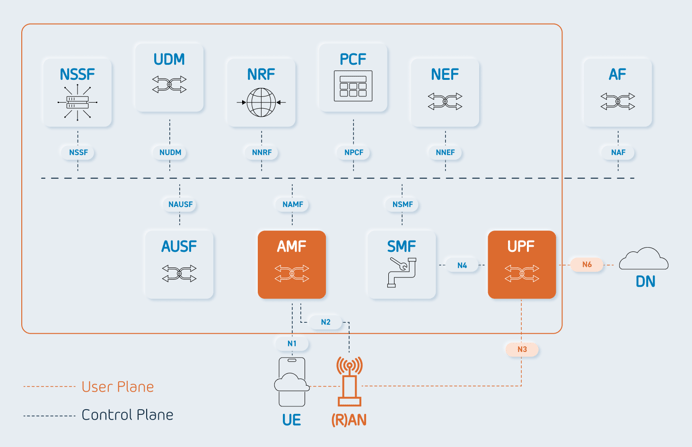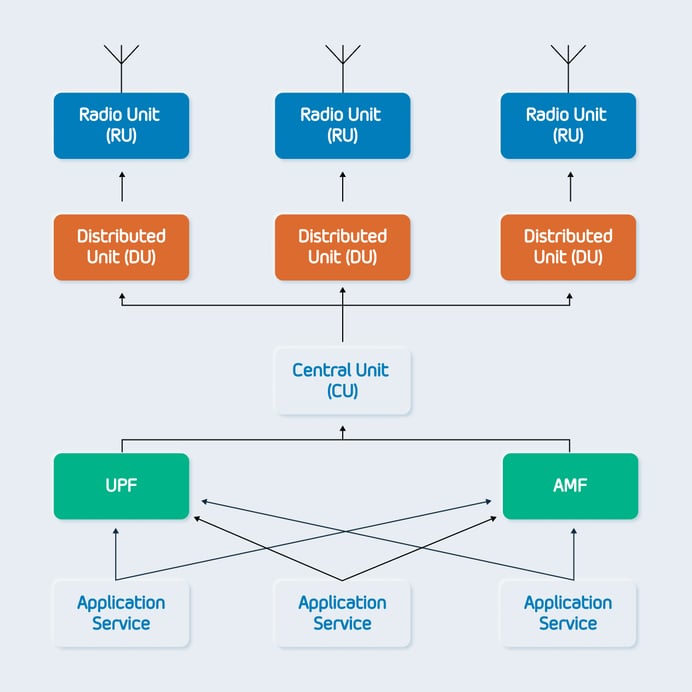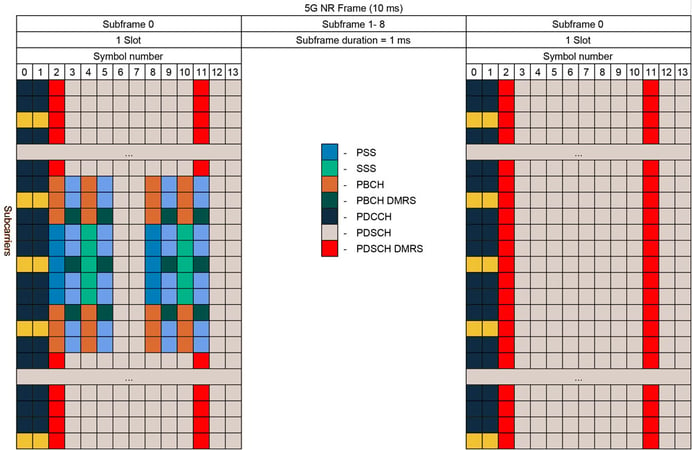
Exploring The Power of 5G Network Architectures: A Journey with Mobica
- 7 minute read
-
Author: Mobica
Dive into the 5G era, where movies stream flawlessly, doctors operate from afar in real-time, and self-driving cars converse seamlessly. It's not just a "faster internet" but a transformative way we connect and experience life. This isn't just a distant dream; it's unfolding now. In the 5G realm, every professional, from techies to visionaries, has a role in shaping this revolutionary landscape. Every contribution makes tomorrow more innovative and impactful. This is why at Mobica, we’re stoked to be making a lasting impact in this space. And we’re hunting for more visionaries to join us and make their mark in the 5G Networking world.
In this comprehensive article, Expert Mobicans with hands-on 5G Network architecture experience provide insights into the intricacies of 5G architecture, the significance of oRAN, and the nitty-gritty of network components.
For those aspiring to make a mark in this field, imagine being at the forefront, developing standalone high-reliability 5G applications tailored for high-stakes sectors like the military. At Mobica, we're pioneering real-world 5G solutions.
Come along on this journey and discover the awesome opportunities that 5G Network Architecture presents for professionals like you at Mobica.
Understanding The 5G Standard
The 5G standard provides detailed specifications for its network architecture, encompassing the core network, the radio access network, and the interfaces between different network elements. The standard enables network slicing, which facilitates the establishment of several virtual networks within one physical 5G network. This adaptability ensures operators can deliver a wide range of services, each tailored for optimal performance.
oRAN: A New Paradigm in 5G Enhancement
oRAN, or Open Radio Access Network, is an enhancement to 5G. In a traditional mobile network, numerous interfaces bridging the logical and physical parts of a mobile system are proprietary or unique to individual vendors. This makes it difficult to use different pieces of equipment from different vendors together. However, with oRAN, these connections become standardised, paving the way for diverse vendors, innovative solutions, and applications, enhancing affordability and broadening its appeal.

Now we can define the components!
A Comprehensive list of 5G network Components
- Radio Unit (RU), Distributed Unit (DU), and Central Unit (CU) create Radio Access Network (RAN), each utilising different platforms for optimal performance.
- User Plane Functions (UPF), Access and Mobility Management Function (AMF) and a few others (shown in the picture below) create a 5G core, which could be virtualised on a single physical platform.

The RU (Radio Unit)
Typically located at cell sites or towers, it houses the essential radio frequency components and antennas. Utilising specialised hardware, such as ASICs, it crafts and deciphers physical radio signals. Its primary role is to send and receive these signals to and from devices like phones or 5G routers, facilitating over-the-air communication.
The DU (Distributed unit)
It runs on high-powered servers equipped with real-time capabilities and is situated near the cell site. Engaging in real-time, low-level baseband functions, it harnesses integrated DSPs to process and decode signals coming from or going to the RU, along with performing additional preprocessing functions.
The CU (Central unit)
Typically housed in data centres and powered by high-capacity servers, this component is positioned deeper in the network. It handles non-real-time, high-level baseband functions like session management, handover decisions, and aggregation of the data prior to forwarding it to the core network.
The UPF (User Plane Function)
It oversees the traffic flow from the RAN to the core network and directs it towards its final destination, such as a server, another device or the Internet. Additionally, the UPF implements quality of service guidelines, influencing how traffic is managed within the RAN.
The AMF (Access and Mobility Management Function)
Oversees users' access to the network and their mobility across different cells in the RAN. This encompasses functions like network registration, connection establishment, and ensuring device accessibility procedures. Furthermore, it orchestrates handovers when a device migrates from one cell to another within the RAN.
The Connection of 5G Network Components
These components are interconnected via high-speed links, similar to how your laptop communicates over the internet via fibre networks. The 5G 3GPP standard defines the data that must be shared between these components and the associated interfaces. For instance, within the RAN, it highlights the front-haul (connecting RU and DU) and mid-haul (linking DU and CU), as well as interfaces like N2/N3 that bridge UPF/AMF and RAN.
Moreover in oRAN, these interconnections are defined through open, standardised interfaces, enabling equipment from different vendors to interoperate seamlessly. This introduces the terminology of O-RU, O-DU, and O-CU, where the 'O' symbolises 'Open' which underscores the commitment to openness and interoperability of these components.

Applications of 5G Network Components
To understand what challenges could emerge during development let’s discuss it as an example. Supposedly our client wants to have high reliability and time-critical service for military purposes which will work on a standalone 5G network deployed on the battlefield. Our task is to configure the network properly and modify some RAN components to make a robust, secure and low-latency solution.
Starting from the top we need to prepare a system environment where the 5G application/service could work. We can do that with Kubernetes which automates and manages docker containers. With a special manifest file, we can create, configure, and manage various resources within a platform so that the client would be able to run their specialised service. This will enable efficient and automated deployment of standalone 5G networks (without access to the Internet/cloud). However, this is just the tip of the iceberg. To make it work 5G Core and RAN need to be properly configured.
On the 5G Core level, we will need to properly configure the network traffic on the UPF function and secure it with AMF mechanisms. By setting proper Quality of Service (QoS) parameters and Service Data Flow (SDF) in UPF we could ensure that the latency and reliability requirements will be met. Also, some specialised encryption/decryption could be done here for downlink/uplink respectively. The AMF will enable us to have control over device access and cryptographic features. For example, we could introduce dedicated cryptographic key storage and exchange mechanisms. This could be essential for military purposes where security needs to be on the highest possible level.

AMF and UPF could then contact the Central Unit (CU) of RAN to properly set up the network. Based on the above settings (i.e. QoS parameters) the CU reserves resources for traffic and maintains synchronisation of the RAN with the core network. It takes high-level parameters from 5G Core and based on them configures the network by sending packets to Distributed Units. Those packets will effectively ensure the robustness and latency of the traffic. This could be done based on oRAN Midhaul specifications to be able to support different vendors of RAN components.
Then, on the Distributed Unit (DU), our primary goal would be to support the interface with the Base Station or Radio Unit (RU). At this level, timing becomes crucial, and any code written for the DU needs to be low-level and real-time, typically in languages such as C or C++. Here we will need to send configuration and user data at specific moments in time (i.e. at the start of the frame/subframe/slot) so that the base station can properly utilise the resources of the wireless channel.
Examples of allocation of those resources for different logical channels like Physical Downlink Shared Channel (for user downlink data), Physical Downlink Control Channel (for control downlink data), PSS/SSS (for synchronisation) and others in a frequency-timing grid are shown below. The DU needs to take into consideration information from CU and also based on the knowledge prepare packets with data and control information for RU i.e. based on oRAN specification. However, it can be customised by adding or modifying specific functions to address specialised requirements i.e. to choose the most suitable frequencies for critical connection.

And last but not least the RU is responsible for efficiently processing the baseband signals received from the Distributed Unit (DU) and preparing them for transmission over the air interface to User Equipment (UE). It might be created based on Software Defined Radio chips which enable i.e. to add some additional error correction mechanisms to make the communication more robust and resistant to interference. If you are familiar with FPGA and DSP technologies you might need those skills here.
Behind the Scenes of 5G Development at Mobica
At Mobica, we have the competencies to craft robust and efficient software for every segment of 5G services and networks, including the Central Unit (CU), Distributed Unit (DU), and Radio Unit (RU). We're committed to continuous learning and innovation, understanding that the tech landscape is ever-evolving. Beyond software development, our expertise lies in seamlessly integrating these components to function cohesively and conducting thorough testing to ensure peak performance. We've already worked with some big-name companies, helping them to create their own standalone 5G solutions. Our track record includes collaborations with industry-leading companies, aiding them in rolling out their bespoke 5G solutions. Engaging in such advanced projects offers our employees immense satisfaction and invaluable experience in forefront technology. Let them speak for themselves:
“I was working on a project for a company that is one of the world leaders in delivering 5G solutions in a market. As a team, we worked on the platform for deploying applications on the edge of the 5G network.
The most exciting part for me was the end-to-end tests we conducted on real hardware. In addition to powerful server machines boasting over a hundred logical cores and several hundred gigabytes of RAM, we had access to 5G-specific devices for testing. Our goal was to simulate the complete journey network packets take from mobile devices to the 5G Edge application or the Internet and back. We had the opportunity to program SIM cards, configure the Radiohead Unit to interact with mobile devices, set up DU and CU servers, onboard 5G applications, and prepare the platform hosting the 5G Core, UPF modules, and network edge applications.
The biggest challenge was configuring the network to enable all the applications to communicate with one another and set up 5G apps and Radiohead to grant mobile access to the local 5G network. As a result, we observed how the mobile subscribed to the 5G network, akin to how it does with real-life mobile operators, and understood the fundamental network packet flowing through all these components to the application deployed at the edge of the 5G network. This experience deepened my understanding of the journey a packet from my mobile takes and the numerous underlying operations required to download a website.”
Mateusz Szelest, Expert Engineer, Embedded Competence Centre at Mobica
Join us, and together, let’s craft the future of 5G!
The breakthroughs in 5G are not merely about faster speeds but about evolving how industries operate. From oRAN to intricate network functionalities, the possibilities are vast and thrilling. At Mobica, we pride ourselves on being part of this change, crafting state-of-the-art 5G solutions that are redefining industries and experiences.
Every innovation at Mobica is fueled by the passion and expertise of our team members, individuals like Mateusz Szelest. Their stories highlight the depth of opportunities at Mobica and the profound impact our team has on the global 5G landscape.
Keep an eye on our careers page for a variety of job updates.
Are you ready to make your own contribution?
Get started with Mobica today!
Contributor

Pawel Gielmuda
In Mobica since 2021
Paweł is a skilled engineer with commercial experience in software development for 5G L1 solutions. Throughout his career, he has acquired practical expertise in hardware, FPGA, and software development for core network devices, emphasising reliability, security, and efficiency. Over the past two years, he has been employed at Mobica, where he specialises in preparing tests for hardware server accelerators.Senior Software Engineer, Embedded Competence Centre
